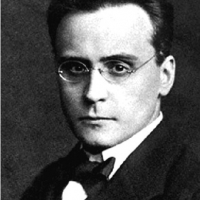Anton Webern
 AUTClassical, Orchestral, Classical Crossover
AUTClassical, Orchestral, Classical Crossover

 AUTClassical, Orchestral, Classical Crossover
AUTClassical, Orchestral, Classical CrossoverComposer Anton Webern was from Salzburg, Austria, and specialized in orchestral and classical music. Along with Arnold Schoenberg and Alban Berg, he was a member of the Second Viennese School and is renowned for his use of serialism and atonal compositions. Brevity and intricacy were hallmarks of Webern's work, which frequently featured brief, snappy compositions with complex harmonies and melodic lines.
Johann Sebastian Bach's work had a significant influence on Webern, who was renowned for his use of counterpoint and devotion to stringent compositional guidelines. His music was frequently characterized as analytical and austere, with an emphasis on form and structure rather than feeling and expression. Despite this, the evolution of modern classical music was greatly influenced by his compositions.
Sadly, Webern's career was tragically ended by his passing during World War II. He was enjoying a cigar outside his house when an American soldier unintentionally shot and killed him. Despite having a short career, Webern's contributions to classical music are still recognized and studied today.
Austrian composer Anton Webern, a well-known name in classical and orchestral music, is responsible for a number of well-known songs that have won over listeners all over the world. "Elf kurze Stucke: No. 4 in A Minor," one of his most well-known songs, is a hauntingly beautiful composition that displays his mastery of the classical style. Another noteworthy work is "Symphony, Op. 21: II. Variationen," which showcases Webern's avant-garde compositional style through elaborate variations on a theme.
The "Variations for Piano, Op. 27" by Anton Webern is another work that is well-liked by fans of classical music. Pieces like "1. Sehr massig," "2. Sehr schnell," and "3. Ruhig fliessend" demonstrate Webern's talent for composing intricate yet beautiful arrangements. Another outstanding work that showcases the composer's expert use of instrumentation and melody is "Two Pieces for Cello and Piano (1899 Version, Ed. Piatigorsky): 1. Langsam - Live at Schloss Elmau, Krun / 2016".
Another well-known piece by Webern that demonstrates his capacity to write extremely emotional and evocative music that connects with listeners is "Langsamer Satz." Last but not least, Webern's "Three Little Pieces for Cello and Piano, op.11 (1914)" is an incredibly lovely composition that demonstrates his talent for writing delicate yet potent music that lingers in the mind long after the final notes have faded away.
Overall, Anton Webern's corpus of work serves as a tribute to his brilliance as a composer and his capacity to produce music that is ageless and universal. He is regarded as one of the greatest composers of all time because of his ability to combine classical forms with cutting-edge compositional methods.
The Austrian composer of orchestral and classical music, Anton Webern, has recently been responsible for some of the most fascinating works of music. His most recent album, "Prism V," which was released in 2023, is evidence of his development as an artist and musical prowess. The album has a variety of songs that demonstrate his proficiency with many instruments and musical genres.
The hauntingly lovely "Webern - String Quartet, Op. 28 (Early 20TH classical for steel guitar)" was released in 2022 and is the composer's most recent single. The tune is a unique and captivating listen because it combines classical and modern music. The same year's release of "Webern: Variations for Piano, Op. 27" is another noteworthy single. This song is a minimalist masterpiece that demonstrates Webern's ability to write music with strong emotional content.
In addition to these two hits, Webern has recently published a number of other songs. "Webern: 4 Pieces for Violin and Piano, Op. 7" released in 2017 is another noteworthy track that highlights his ability to create music that is both technically challenging and emotionally resonant. "Passacaglia Op 1" released in 2021 is a beautiful composition that highlights Webern's skill in creating complex and layered music.
In conclusion, Anton Webern is still creating some of the most intriguing and avant-garde classical and orchestral music. His most recent album and singles are evidence of his artistic development. He establishes himself as a musician who isn't afraid to stretch the limits of traditional music and produce something wholly original with each new release.
The Austrian composer Anton Webern has collaborated with various artists on a number of significant works over the course of his career. His work with the Philharmonia Orchestra and Robert Craft on "6 Pieces, Op. 6 (revised version): I. Langsam" was one of his most noteworthy collaborations. The composition exemplifies Webern's serialism technique, which uses a series of melodic notes to build the work. Together with Robert Craft, who is renowned for his interpretation of Webern's works, the Philharmonia Orchestra gives this piece a potent rendition.
Another notable collaboration was "Variations for Piano, Op. 27: 2" with pianist Maurizio Pollini. Very quickly. The complexity of Webern's piece is highlighted by Pollini's virtuoso playing, which also shows the composer's use of dissonance and unusual harmonies. Although the piece is difficult to perform, Pollini's technical prowess makes it seem easy.
Last but not least, Webern worked with the Novus String Quartet to create the string quartet "Langsamer Satz," which exhibits Webern's Romantic side. The music deviates from Webern's normal atonal and serialist works by utilizing lush harmonies and a more conventional structure. The piece is beautifully performed by the Novus String Quartet, who successfully convey the sentiment and allure of Webern's Romantic side.
Overall, Anton Webern's musical partnerships have produced some of the most significant pieces in the canon of classical music. These partnerships have made it possible to interpret Webern's compositions in a variety of ways, displaying the breadth and complexity of his output.